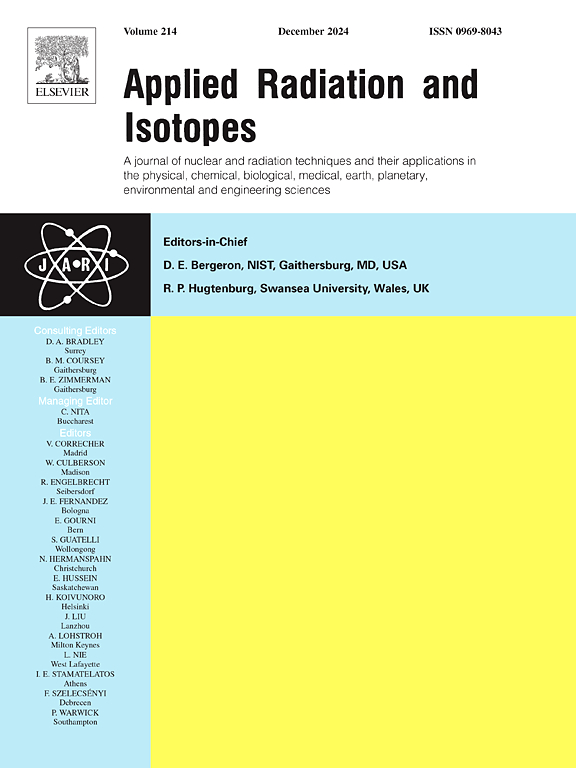Comparative efficacy of reactor vs. accelerator-based boron neutron capture therapy in U87MG glioblastoma models
IF 1.6
3区 工程技术
Q3 CHEMISTRY, INORGANIC & NUCLEAR
引用次数: 0
Abstract
Boron neutron capture therapy (BNCT) has emerged as a promising treatment for cancer, utilizing the interaction between thermal neutrons and boron-10 to selectively target and destroy cancer cells. This study evaluates the efficacy of BNCT using 4-borono-L-phenylalanine (BPA) in two different systems: reactor-based BNCT at Kyoto University Reactor (KUR) and accelerator-based BNCT at the Aomori Prefectural Quantum Science Center (QSC). The QSC cyclotron accelerator (HM-20V; Sumitomo Heavy Industries, Japan) operates a lower neutron generation capacity compared to the cyclotron accelerators (HM-30; Sumitomo Heavy Industries, Japan) used in clinical settings at Kansai BNCT Clinical Center in Osaka Medical Pharmaceutical University and Southern Tohoku Hospital. Using U87MG glioblastoma-bearing mouse models, we compared the therapeutic outcomes of both systems. This result may be partially attributed to the higher gamma-ray dose delivered by the QSC accelerator compared to KUR, which may enhance cytotoxic effects and help compensate for the lower neutron dose. Additionally, possible differences in overall neutron spectra delivered by the two different sources (KUR and QSC) used in the work described here could also have contributed to the observed outcomes.
反应器与加速器型硼中子俘获治疗U87MG胶质母细胞瘤模型的疗效比较
硼中子俘获疗法(BNCT)利用热中子和硼-10之间的相互作用来选择性地靶向和破坏癌细胞,已成为一种很有前途的癌症治疗方法。本研究在两个不同的系统中评估了使用4-硼- l -苯丙氨酸(BPA)的BNCT的效果:京都大学反应堆(KUR)基于反应器的BNCT和青森县量子科学中心(QSC)基于加速器的BNCT。QSC回旋加速器(HM-20V;日本住友重工(Sumitomo Heavy Industries)的中子生成能力低于回旋加速器(HM-30;在大阪医药大学关西BNCT临床中心和南东北医院的临床环境中使用。使用U87MG胶质母细胞瘤小鼠模型,我们比较了两种系统的治疗效果。这一结果可能部分归因于与KUR相比,QSC加速器提供的伽马射线剂量更高,这可能增强细胞毒性作用并有助于补偿较低的中子剂量。此外,在这里描述的工作中使用的两种不同源(KUR和QSC)提供的总体中子谱的可能差异也可能导致观察到的结果。
本文章由计算机程序翻译,如有差异,请以英文原文为准。
求助全文
约1分钟内获得全文
求助全文
来源期刊

Applied Radiation and Isotopes
工程技术-核科学技术
CiteScore
3.00
自引率
12.50%
发文量
406
审稿时长
13.5 months
期刊介绍:
Applied Radiation and Isotopes provides a high quality medium for the publication of substantial, original and scientific and technological papers on the development and peaceful application of nuclear, radiation and radionuclide techniques in chemistry, physics, biochemistry, biology, medicine, security, engineering and in the earth, planetary and environmental sciences, all including dosimetry. Nuclear techniques are defined in the broadest sense and both experimental and theoretical papers are welcome. They include the development and use of α- and β-particles, X-rays and γ-rays, neutrons and other nuclear particles and radiations from all sources, including radionuclides, synchrotron sources, cyclotrons and reactors and from the natural environment.
The journal aims to publish papers with significance to an international audience, containing substantial novelty and scientific impact. The Editors reserve the rights to reject, with or without external review, papers that do not meet these criteria.
Papers dealing with radiation processing, i.e., where radiation is used to bring about a biological, chemical or physical change in a material, should be directed to our sister journal Radiation Physics and Chemistry.
 求助内容:
求助内容: 应助结果提醒方式:
应助结果提醒方式:


